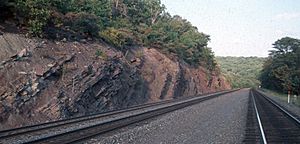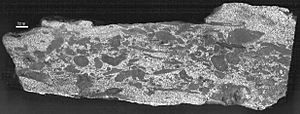Catskill Formation facts for kids
Quick facts for kids Catskill FormationStratigraphic range: Devonian |
|
|---|---|

A rock outcrop of the Irish Valley Member of the Catskill Formation near the Horseshoe Curve in Blair County, Pennsylvania
|
|
| Type | sedimentary |
| Underlies | Rockwell Formation, Huntley Mountain Formation, Pocono Formation, Spechty Kopf Formation |
| Overlies | Foreknobs Formation, Lock Haven Formation, Trimmers Rock Formation |
| Thickness | Up to 10,000 ft (3,000 m) |
| Lithology | |
| Primary | Sandstone |
| Other | Siltstone, shale |
| Location | |
| Region | Appalachian Mountains |
| Country | |
| Extent | |
| Type section | |
| Named for | Catskill Mountains, New York |
The Catskill Formation is a type of rock found mostly in Pennsylvania and New York. It's made of sedimentary rock, which means it formed from layers of sand, mud, and other materials. This rock unit is very thick, reaching up to 10,000 feet (3,000 m) in some places. It formed during the Devonian period, a long time ago.
The Catskill Formation is also known as the Catskill Clastic Wedge. It's a huge layer of rock that makes up much of the Upper Devonian bedrock in northeast Pennsylvania and the Catskill Mountains region of New York. The Pocono Mountains in Pennsylvania also sit on top of this rock. Most of the rocks in the Catskill Formation are red sandstone. This red color tells us that the rocks were formed on land, not in the ocean. This happened during a time when mountains were forming, called the Acadian orogeny.
Contents
How the Catskill Formation Was Made
During the Devonian period, the area where the Catskill Formation is now was a huge delta system. Imagine many rivers flowing into a shallow sea, dropping off lots of sand and mud. This area was like a big marshy plain. It was located between a large inland sea called the Kaskaskia Sea and a mountain range called the Acadian Mountains.
Over millions of years, rivers carried sediment, like sand and mud, from the Acadian Mountains. This sediment was deposited to the west, forming the deltas. Eventually, these layers of sediment were buried deep underground. The pressure and heat turned them into the sandstone and other rocks we see today. Later, when the Catskill Mountains and Appalachian Mountains formed, these buried rocks were pushed up to the surface.
The Catskill Formation is important because it helped create the petroleum (oil) found in western Pennsylvania. This region was one of the first places where oil was discovered and drilled.
How Glaciers Shaped the Catskill Mountains
The Catskill Mountains were formed during the same mountain-building event as the Appalachian Mountains. However, the Catskills also experienced something different: erosion by glaciers. Much of the shape of the Catskill Mountains today is because of the Wisconsin glaciation. This ice age ended only about 12,000 years ago.
Clues from the Ice Age
There are many signs that show how glaciers carved the Catskill Mountains. These clues help scientists understand what happened during the Glacial period.
Some of these signs include:
- Glacial Erratics: These are large rocks that were carried by glaciers and then left behind when the ice melted. An example is the Devils Tombstone.
- Striations: These are scratches on rocks made by glaciers dragging other rocks over them.
- "Dance Floors": These are flat, polished rock surfaces, like Pratt Rock, where glaciers smoothed the land.
- Terminal moraines: These are piles of rocks and dirt left at the very end of a glacier.
Members of the Catskill Formation
The Catskill Formation is so large that it's divided into smaller parts called "members." These members are different layers of rock that formed in slightly different ways or at different times.
Eastern Pennsylvania Members
In eastern Pennsylvania, some of the members include Towamensing, Walcksville, Beaverdam Run, Long Run, Packerton, Poplar Gap, Sawmill Run, Berry Run, Clarks Ferry, and Duncannon.
Central Pennsylvania Members
In central Pennsylvania, you can find members like Irish Valley, Sherman Creek, Buddys Run, Clarks Ferry, and Duncannon.




